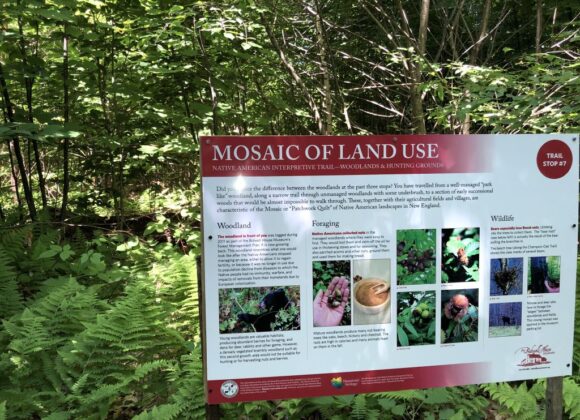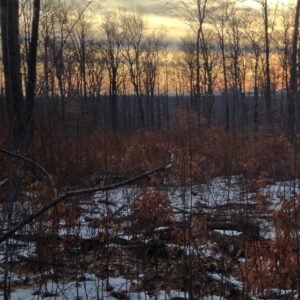Native American History
Native Americans have lived in this region for over seven thousand years. The indigenous peoples to this area are the Mohican Nation, who numbered about 20,000 people, and flourished in the Hudson River valley and Housatonic River valley. They used the upland woodlands including Monterey for their hunting grounds.
The Native American displays at the Bidwell House Museum generally illustrate the pre-contact period prior to the 1600s. In the Carriage Barn, you will find a brief history of the Mohicans – the Muh-he-con-neok – “the People of the Waters That Are Never Still” – who became known as the Stockbridge-Munsee after living in Stockbridge in the 1700s. Our Native American Interpretive Trail tells more of their story and relationship with this land.
Although the Stockbridge Indians were forced to relocate westward in the 1780s, this area remains their sacred homeland and the tribe maintains a strong connection here. However, their story is not something relegated to the distant past: today, the Stockbridge-Munsee are a federally-recognized Indian Nation and a vibrant community based on a reservation in Wisconsin. They maintain a regional Tribal Historic Preservation Extension Office locally, which recently moved from Troy, NY, to the campus of Williams College in Williamstown. You can learn more on their website: https://www.mohican.com/
Native American Interpretive Trail
In 2018 the Museum, in cooperation with the Stockbridge-Munsee Band of the Mohican Indians and the Upper Housatonic Valley National Heritage Area, created a new interpretive trail that retraces the steps of the Native Americans—specifically the local Stockbridge Band of the Mohican Tribe—who lived and hunted in this area for thousands of years. In 2020, this self-guided walk was expanded from four stops to eight stops on the property with educational displays at each point that tell the story of the Native American presence on this land. Maps for this hike can be found at the parking kiosk or downloaded HERE. Occasionally we offer guided versions of this hike, so check our events page to see when the next hike is scheduled.
Footprints of Our Ancestors: Mohican History Walking Tour of Stockbridge
The Stockbridge-Munsee Community Band of Mohican Indians, in partnership with the Upper Housatonic Valley National Heritage Area, have created a guided walking tour entitled Footprints of Our Ancestors: Mohican History Walking Tour of Stockbridge. This can be experienced virtually in this time of limited travel, with the help of an interactive map and a series of videos, available on their website HERE. If you have the opportunity to visit the town of Stockbridge, the tour is also available for download so you can explore in person. Download the tour HERE.

One artistic rendering of Konkapot in the Town of Lee, Mass. on a historic fountain. Konkapot’s direct descendants, Stockbridge-Munsee Mohicans Sioux Collom and her grandmother, JoAnn Schedler, participated in a 2019 re-dedication ceremony at the fountain featuring their beloved Magnificent Mohican ancestor.
Bidwell Lore: The Mohicans
In 2020, we launched our weekly newsletter, Bidwell Lore. In this, we explore a variety of topics pertaining to the history of the Bidwell House; in recent months, the focus has turned from the Bidwell family to the earlier residents of the area. In conjunction with our winter speaker series, Hidden in Plain Sight: Native Peoples and the Struggle to Recover Their History in New England, we’ve explored a variety of topics pertaining to Mohican history.
These include:
Muh-he-con-neok or ‘People of the Waters that are never still
Indian Town’s Mohican Burial Ground
and several more.
To read all the installments, including a range of topics relating to the Bidwell family and early American history, visit our blog HERE.
Jonathan Edwards and the Stockbridge Mohican Indians: His Mission and Sermons
Our first speaker will be Dr. Roy M. Paul, who will talk about his book Jonathan Edwards and the Stockbridge Mohican Indians. The story of the Stockbridge Mohicans is one of tragedy and deceit, and yet also a story of endurance and strength. Despite the many efforts to remove their identity and eradicate their unique culture, they have endured and continue to flourish, ensuring future generations will benefit from their rich legacy. In his book, Dr. Paul chronicles the history of the Mohican people and their desire to know more about the “Great, Good Spirit.” From 1751-1758 they were ministered by Jonathan Edwards, the foremost theologian in American history, and Paul’s book gives you a glimpse of that relationship and of Edwards’ efforts for their physical and spiritual well-being.
Dr. Roy M. Paul was born in Perth, Ontario, Canada. He completed a B.A. in Chemistry and Psychology from Queen’s University and an Honours B.Sc. in Biomedical Toxicology from the University of Guelph. After a successful 25-year career at Johnson & Johnson, he took an early retirement. Feeling unsettled and still eager to learn, Paul attended Heritage Theological Seminary in Cambridge, Ontario, completing a Master of Theological Studies, magna cum laude. He subsequently went on to complete a Th.D. in Church History, and currently serves as the Executive Research Assistant at the Canadian office of the Andrew Fuller Centre for Baptist Studies.
Finding A Place Again: Honoring the Mohican Story of Stockbridge
Though indigenous history in Stockbridge stretches back at least 12,000 years, the colonial-era Mohican story is bookended by two key events: the 1739 construction of the Stockbridge Meetinghouse, and the 1783 Ox Roast feast to thank Stockbridge Mohicans for Revolutionary War service—as they were simultaneously forced to leave these lands for the west. Stockbridge-Munsee Mohican Nation is investigating both of these important and complex sites through archaeology and historical research, awakening new perspectives on these events. The Meetinghouse and Ox Roast sites are also but two of eleven sites that were included in the Tribe’s recent release of an online Mohican History Walking Tour of Stockbridge Main Street. Join for a discussion of these cultural heritage initiatives presented by Bonney Hartley.
Bonney Hartley is a cultural resources professional who is currently the Tribal Historic Preservation Manager of the Stockbridge/Munsee Mohican Nation, of which she is also an enrolled member. Her work focuses on the repatriation of ancestors and objects important to the Tribe’s cultural heritage. Bonney holds a Masters of Social Science Degree in International Relations from the University of Cape Town, South Africa. In 2013 she was awarded the “American Indian Local Hero Award” by the San Francisco Mayor’s office. Bonney also serves on the Board of Trustees of Historic Huguenot Street in New Paltz, NY.
Cultivating Memorial Geographies and Collective Memories
Though the Stockbridge-Munsee Mohicans were forced to leave their homelands in 1783, they have never relinquished their ties to the Mahicannituck River Valley and have continued to return to this region over the last 238 years. In this talk, Dr. Rose Miron discusses the heritage tourism trips organized by the tribe’s Historical Committee in the late 20th century, which brought busloads of tribal citizens back to the Northeast to learn about Mohican history. The trips allowed tribal citizens to recreate the geographies in which their ancestors lived and cultivate new collective memories that strengthened a shared sense of tribal history, laying the foundation for future interventions in regional museums and other public history sites.
Rose Miron is the Director of the D’Arcy McNickle Center for American Indian and Indigenous Studies at the Newberry Library in Chicago. She holds a B.A. in History with a minor in Spanish and a Ph.D. in American Studies from the University of Minnesota. Her research explores Indigenous interventions in public history within the Northeast and the Great Lakes regions, as well as American Indian sovereignty and activism in the twentieth century. She is currently working on a manuscript project tentatively titled “Indigenous Archival Activism: Reclaiming Native History in the Mohican Tribal Archive and Beyond.” The project is based in close collaboration with the Stockbridge-Munsee Mohican Nation since 2011 and explores how Native people use archives to change the way Indigenous history is accessed and produced.
LAND ACKNOWLEDGEMENT
from the Stockbridge-Munsee Community of the Mohican Tribe
It is with gratitude and humility that we acknowledge that we are learning, speaking and gathering on the ancestral homelands of the Mohican people, who are the indigenous peoples of this land.
Despite tremendous hardship in being forced from here, today their community resides in Wisconsin and is known as the Stockbridge-Munsee Community.
We pay honor and respect to their ancestors past and present as we commit to building a more inclusive and equitable space for all.


